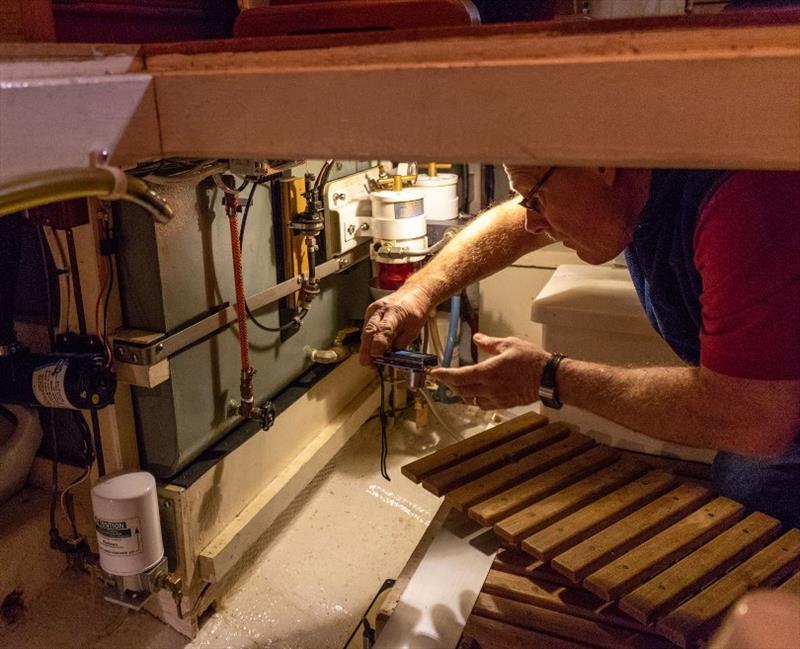
Giving Even Keel an electronics backbone
by Lyman-Morse Boatbuilding 2 Apr 2019 02:16 PDT

Giving Even Keel an electronics backbone © Lyman-Morse Boatbuilding
As we all know, running a boat requires managing the complex forces of wind, current, and energy, and managing the electronics network that keeps them all in check takes a deft touch indeed.
Let us introduce you to Mike Gaulin, one of the crew with the magic marine electronics hands at Lyman-Morse at Wayfarer in Camden. He got his start installing such gear into Sturgeon-Class fast attack nuclear submarines in the Navy, before joining Wayfarer Marine 10 years ago. For Gaulin and his team of four, every job starts with bench-testing, even on electronics built by trusted manufacturers like Raymarine, B&G, KVH, Garmin, and Furuno.
"Every piece of electronics gets tested before it goes into a boat," he says. "Today's gear is finicky."
Once they've passed that test, the key to turning these various components into a single robust electronics network involves creating a vessel's electronics backbone.
Finding a boat's backbone
Gaulin uses Even Keel, a classic Grand Banks 32 cruiser as an example of how he designs a boat's electronics backbone. He starts by sketching out a schematic of the various instruments and cables that a system might require, using a computer-assisted drawing (CAD) software package.
This CAD drawing maps out the various configurations of the instruments and cables needed and how each will adhere to the exacting specifications of the National Marine Electronics Association, the trade group that defines how devices from various makers communicate on a boat.
These National Marine Electronics Association (NMEA) standards – usually nicknamed "neema" by those in the marine industry – are utterly unlike the internet communications network tools most people use on land. Instead, NMEA standards are a relative of proprietary communications tools found in cars and trucks. They are closed systems that require exactly specified backbone infrastructures of multi-stranded cables, connectors, and software.
"The big difference between NMEA and the internet is that a NMEA network carries not only data, but also power to a device," says Gaulin. "And you have to be careful to design your network to manage both."
Right backbone, right user
On Even Keel, the main backbone is a 45-foot-long cable made up of an internal power line, a ground line, a so-called high data line, a low data line, and then a shield.
"What you design with that backbone depends on the experience of the skipper," says Gaulin. Some owners want more powerful electronics, no matter the complexity. Others want a simpler experience, maybe closer to what they find in their cars.
In Even Keel's case, the owner was all about flexibility and functionality. The boat features two separate helming stations, one on deck and one on a fly-bridge. Each includes its own Garmin 7610 chart plotter that features radar and navigation displays, There are redundant autopilots, several networked VHF radios, a complex Fusion marine entertainment system, a Flir fixed-mount thermal night-vision camera, as well as forward-looking Sonar systems, and down view and sideview depth imaging tools, There is also a Floscan fuel consumption meter that ensures the vessel never runs out of diesel.
The challenge with Even Keel, given its density of electronics, is the NMEA standard strictly requires that each device have its own dedicated connection, or drop cable, from the main backbone line to the device. These drop cables tie-in with the backbone via dedicated T-connectors and can have a maximum length of no more than 6 meters, or about 18 feet.
For a 32-foot boat with three levels, like Even Keel, the backbone then must be carefully snaked to run from up on the fly-deck, down through the main deck, and then down further into the engine room.
"What you are looking for is a physical redundancy where there are no single points of failure," says Gaulin. "If one cable is broken or a unit fails, I have to be able to disconnect that unit and not compromise the system."
Once the basic backbone and drop cables are installed, he has figure out how to integrate older electronics systems with modern tablets and smartphones.
"More and more, modern marine electronics have WiFi integration. That means an owner's iPhone can be a handy extra wireless display, for something like a radar readout," says Gaulin.
"They like carrying that kind data around anywhere on the boat. These are the tools that give owners more confidence to get home safely."